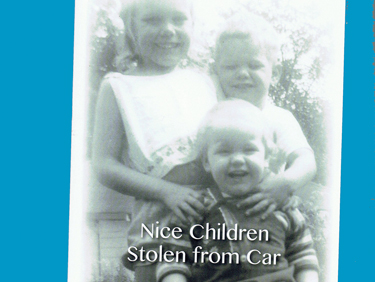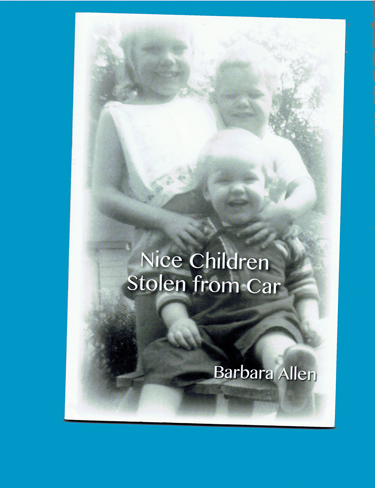

By Ann Needle
Barbara Allen grew up in a household brimming with trash, shoes, newspapers, and whatever else her father could stuff in. As a child of a hoarding parent, Allen described to an audience at Randall Library the effects of hoarding behavior on the hoarder’s family. Saturday’s panel discussion, hosted by Library Director Melissa Fournier, also included hoarding and safety experts who attested to just how this obsession with the collection of “stuff” extends far beyond the person who is hoarding.
Allen, of Bolton, peppered her discussion with readings from her book about growing up with a hoarder, Nice Children Stolen from Car. Allen started to write the book about three years ago, aiming to offer some hope to adults who grew up with a parent that was a hoarder, or who had any other psychiatric issue. “At the time, hoarding was just becoming a topic,” but little was being written about the effects on hoarders’ families, she said.
Allen spoke of looking for adoption papers, as a teenager, about 40 years ago, among socks on the floor and, “Church bulletins from 1955.” The reason? Allen was convinced she could not possibly be a biological product of her father. Another fanciful theory for how she ended up in her family — where her mother surrendered to her father’s behavior — was she was one of the “nice children stolen from a car, while her parents were just inside the store buying milk.” Hence, the title of her book.
In readings from her book, Allen underscored the frustration of her and her siblings over why their house could not look like their friends’. In Allen’s household, if anyone did search for an item, Allen stressed the importance of putting all that junk back precisely where it belonged, because, “Dad would know even if you moved the smallest piece.” Her father fancied himself a collector—whether it was of a catalog or a used pizza box—and would never have termed himself a hoarder, even with “the rancid grease that lies on the stove in open baby food jars,” she explained. And there were two stoves in their kitchen, both broken. However, Allen recalled, “You couldn’t throw them out.”
Who Hoards
Panel member Michele Matties, who works as a professional organizer out of Framingham, estimated that 2% to 5% of the American population can be considered hoarders. “There is a good portion of this that’s not seen,” she remarked, noting that hoarding behavior is usually not known to the public until relatives or friends of the person call officials for help.
For observers who do make it into a hoarder’s house, Matties said that a major symptom of hoarding is, “Things are not being used the way they should be. The shower, all of a sudden, becomes a storage room.” Matties noted that there often is a genetic connection to the hoarder; in Allen’s case, her father’s father also was a hoarder. Matties said that hoarding recently became an official psychiatric diagnosis, which should help Americans better understand the impact of this condition on public health and safety.
“It is not curable at this point,” Matties said. “This disorder is a lifelong concern. It is very, very, very slow work, and there is no miracle drug, no miracle cure to fix it.”
Helping a hoarder get his or her life (and property) back into recognizable shape usually means bringing in a team of professionals — from town health boards and police, to psychiatrists and physicians — to assess what this person needs, according to panel member Michelle Caron of the Visiting Nurse Association. As a forensic nurse, Caron explained that she often explores the hoarder’s house for clues as to what sorts of physical and mental health services a person may need. For instance, a lack of clean water may point to the person being chronically dehydrated and dizzy, Caron said.
These conditions also can work in reverse, with Caron noting she has been called to emergency rooms several times when a suspected hoarder comes in to treat a fall sustained at home. At that point, Caron said she reaches out to the person’s doctors, psychiatrists, and family, “So I can create a team that can really go in and help someone.”
“A lot of times, we’ll have hoarders in town, and we don’t know about them,” agreed Stow Fire Chief Michael McLaughlin, also sitting on the panel. It’s when safety personnel answer a call for a fire or other emergency at the home that the situation is unveiled. McLaughlin said, “When you talk about cleaning up or getting rid of the stuff, they get very defensive about it. We try not to use the word ‘hoarder’ – we talk public safety.” McLaughlin remarked that this is when a team from the Board of Health, the Police, and the Council on Aging (if the person is older) will try to work together to turn things around.
“It’s a mammoth fire hazard,” said McLaughlin. “The floors can end up collapsing a lot sooner than in a normal house,” because the water sprayed weighs down the often-overwhelming amount of paper piles in the house. He said that, since 2010, there have been hoarder-related deaths reported in New York, California, and Connecticut.
Allen’s book offered a glimpse of where this unchecked hoarding can lead. She recalled a time when state welfare services seriously threatened to take Allen and her siblings from her parents. The case was dropped when neither she nor her siblings would testify against their parents. Years went by, Allen and her siblings moved out, the roof of the house eventually collapsed. After that, her parents moved on “to a different house, a different town. Their new house quickly became just as full of stuff as the old one ever was.”
Asked about her own housekeeping skills, Allen laughed and responded that her house is, indeed, an orderly place, but “normal” and so are the homes of her siblings. While their parents recently cleaned their yard when faced with paying a town-imposed fine if they didn’t, the interior of the house remains the same.